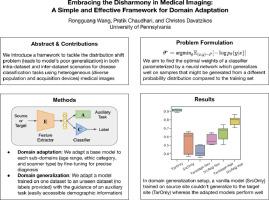Medical Image Analysis ( IF 10.7 ) Pub Date : 2021-11-26 , DOI: 10.1016/j.media.2021.102309 Rongguang Wang 1 , Pratik Chaudhari 2 , Christos Davatzikos 3

|
Domain shift, the mismatch between training and testing data characteristics, causes significant degradation in the predictive performance in multi-source imaging scenarios. In medical imaging, the heterogeneity of population, scanners and acquisition protocols at different sites presents a significant domain shift challenge and has limited the widespread clinical adoption of machine learning models. Harmonization methods, which aim to learn a representation of data invariant to these differences are the prevalent tools to address domain shift, but they typically result in degradation of predictive accuracy. This paper takes a different perspective of the problem: we embrace this disharmony in data and design a simple but effective framework for tackling domain shift. The key idea, based on our theoretical arguments, is to build a pretrained classifier on the source data and adapt this model to new data. The classifier can be fine-tuned for intra-study domain adaptation. We can also tackle situations where we do not have access to ground-truth labels on target data; we show how one can use auxiliary tasks for adaptation; these tasks employ covariates such as age, gender and race which are easy to obtain but nevertheless correlated to the main task. We demonstrate substantial improvements in both intra-study domain adaptation and inter-study domain generalization on large-scale real-world 3D brain MRI datasets for classifying Alzheimer’s disease and schizophrenia.
中文翻译:

拥抱医学成像中的不和谐:一个简单有效的领域适应框架
域转移(训练和测试数据特征之间的不匹配)会导致多源成像场景中的预测性能显着下降。在医学成像中,不同地点的人群、扫描仪和采集协议的异质性提出了重大的领域转移挑战,并限制了机器学习模型的广泛临床采用。协调方法旨在学习对这些差异不变的数据表示,是解决域转移的常用工具,但它们通常会导致预测准确性下降。本文从不同的角度来看待这个问题:我们接受数据中的这种不和谐,并设计一个简单但有效的框架来解决领域转移。基于我们的理论论证,关键思想是在源数据上构建预训练的分类器,并使该模型适应新数据。分类器可以针对研究域内的适应进行微调。我们还可以解决无法访问目标数据上的真实标签的情况;我们展示了如何使用辅助任务来进行适应;这些任务采用年龄、性别和种族等协变量,这些变量很容易获得,但仍然与主要任务相关。我们展示了在大规模现实世界 3D 脑 MRI 数据集上的研究内域适应和研究间域泛化方面的重大改进,用于对阿尔茨海默病和精神分裂症进行分类。











































 京公网安备 11010802027423号
京公网安备 11010802027423号